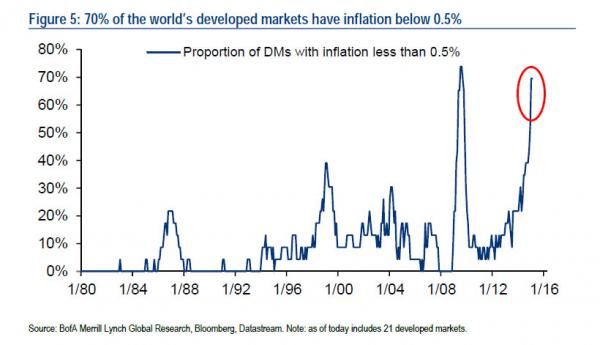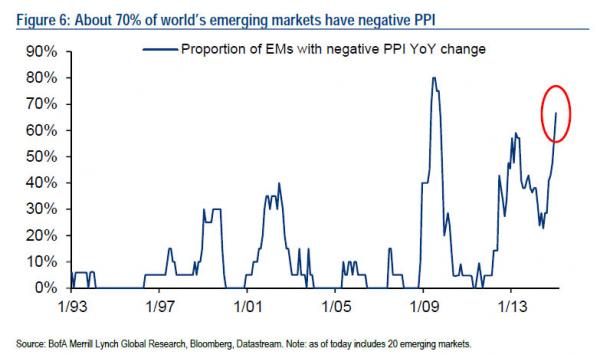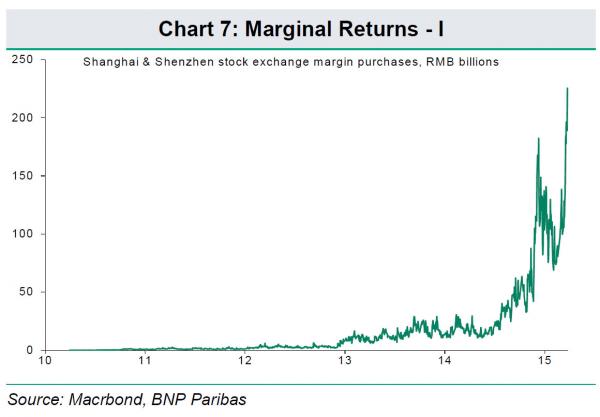
THE COURSE PRESCRIBED BY KEYNES
April 9, 2015
This month let’s
continue our discussion regarding the evolving global economic landscape
in the world of unprecedented monetary policy.
Increasingly, central bank policies are driving the pricing of
assets; as asset prices become more disconnected from underlying
fundamentals. While prices
continue to rise, economic weakness persists but that does not matter in
an environment where any return is better than nothing found in low risk
instruments, courtesy of our Federal Reserve.
The danger lies in the fact that the deteriorating marginal
prospective return from various asset classes lies juxtaposed to a
significant and widening probability of meaningful losses when prices
reconnect to reality. The
Fed has engineered an uninterrupted climb in pricing so that investors
are willing to accept lower and lower returns in the belief that any day
of reckoning is sufficiently far away or simply will not happen for the
fact that it has not happened yet after all this time.
The Economic Cycle
Research Institute [ECRI] recently penned an article that identifies
what may be coming next from global governments in the wake of continued
economic weakness. The
following text is from a piece from April 1 titled “Circling The Drain.”
“The world today is
awash in unprecedented amounts of debt – more than ever before in human
history. According to
McKinsey, all major economies today have higher Debt/GDP ratios than in
2007, with corporate debt about 1.5 times, and government debt over 1.75
times as large. As a result,
global debt has grown to some $200 trillion.”
“In the aggregate, the
two ways these debts can be repaid over time are by generating
sufficient real growth to do so; or by inflating away the debts, so that
they can be repaid in currency that is worth much less.”
“As we have pointed out
before in the context of ‘the yo-yo years,’ real GDP growth has been
stair-stepping down for decades in most advanced economies.
More recently we have also noted
that export prices – especially for emerging economies – have been
exhibiting deflationary patterns for years, and those for advanced
economies are also showing deepening deflation (International Cyclical
Essentials, January 2015).”
“The hard reality is
that there is no magic bullet to get stronger growth – certainly not QE,
which merely attempts to pull demand forward from the future, leaving
even less residual demand for later. The
other way out of the debt trap – generating inflation – is not really
possible through currency devaluation because, in the aggregate, the
pressures are on every economy to devalue along with others.”
“At best, economies can
take turns devaluing their currencies, as they are doing now, but
without much success in igniting inflation.
For instance, Japanese core
inflation, adjusted for last year’s tax hike, has now dropped to zero.”
“The larger point is
that, in the fullness of time, all the major economies are likely to
face a day of reckoning – and earlier than most expect.
Sooner or later, the prospects
of default or an equally unpalatable alternative like much higher taxes
is likely to loom. But the
process may involve a rush to a succession of ‘safe’ assets in the
interim, even though all of these economies are effectively circling the
drain.”
“Desperate but
ineffectual efforts to attain ‘escape velocity’ or even the inflation
target are failing, despite round after round of QE.
To quote John Maynard Keynes
from eight decades ago, ‘When the rate of interest has fallen to a
very low figure and has remained there sufficiently long to show that
there is no further capital construction worth doing even at that low
rate, then I should agree that the facts point to the necessity of
drastic social changes directed towards increasing consumption.
For it would be clear that we
already had as great a stock of capital as we could usefully employ.’
What drastic social changes the
present situation might ultimately require remains to be seen.”
IT’S NOT WHAT YOU CAN DO FOR
YOUR COUNTRY, BUT WHAT WE CAN DO FOR YOU…
Instead of following
the more prudent economic thought found in Austrian economic beliefs
which disagree with Keynes, our political leaders including the Federal
Reserve believe that Keynesian philosophies that promote the government
doing more and more in times of economic strain work best.
It is probably more their wanting to convey to their constituents
“all that they are doing to help them” and/or for the retention of
power, instead of a true understanding of the economic consequences,
that make virtually all governments pursue the ideals of Keynes.
Therefore, if we are
going to continue to be led by the belief that government is the answer
in times of economic weakness instead of letting free markets work, we
should pay attention to the quote by Keynes in the article from ECRI.
Let me quote it once again since it has significant ramifications
to what may be coming sooner than later.
“When the rate of interest has fallen to a very low figure and
has remained there sufficiently long to show that there is no further
capital construction worth doing even at that low rate, then I should
agree that the facts point to the necessity of drastic social changes
directed towards increasing consumption.
For it would be clear that we already had as great a stock of
capital as we could usefully employ.”
Let’s take a look each
part of his statement briefly.
Interest rates are at zero and have been there for going on seven
years. And, the economy
remains very weak with muted capital spending.
That should be sufficient to satisfy Keynes’ criteria for moving
on to his recommendation for the necessity of drastic social changes to
increase consumption. The
final part of his quote basically suggests that once the economy has
reached that point, more monetary policy actions will have little
effect. I would argue that
monetary policy has had more of a detrimental effect, but we are looking
here at the perspective of our political leaders to anticipate what they
may conjure up next.
So, that leads to the
action of “drastic social changes directed towards increasing
consumption.” If we did not
have gridlock in Washington, we would already be seeing the beginnings
of such action. Who knows
what types of actions the government may think of but we will likely see
tax and spend programs surface that are more radical than we have seen
before. If you do not think
so; who would have imagined as late as 2006, the radical monetary
actions that have subsequently occurred?
Remember, the
politicians have a strong incentive to be able to tell their
constituents that they are doing something to help the situation.
The problem is that much of the problem comes from what they have
done before, so more radical ideas are likely to dig the hole deeper.
Think this is far-fetched?
Just remember the social agenda a number of years ago by our
government, that everyone should own a home.
That “entitlement” subsidized purchases of homes with too much
cheap and easy debt by people who were not in position to afford it, and
that led to a massive bubble and bust.
IT’S ABOUT WHOM HAS THE
PROCLIVITY TO CONSUME…
One factor that will
likely influence the “drastic social changes directed towards increasing
consumption” is the growing income gap between the middle-to-low income
earners and the high income earners.
The gap is at historical highs and many of the initial tactics
will likely be focused on taking more from the high income group and
trying to push it into the hands of the lower income group for the
purposes generating more “consumption” [which is spending] in the
economy. Just read the
latest thoughts from Mohamed El-Erian who used to be the CEO of Pimco
and is a significant influencer of economic policy within the
government.
“Income inequality has
risen so much that consumption as a whole is undermined.
That’s because rich people have
a much lower propensity to consume than poor people.
But it is the rich people that
have captured all the income growth for the last seven years.”
“A little bit of
inequality is good for the system because it creates incentives.
A lot of inequality actually
creates negative economic effects. It
has become an inequality of opportunity.”
“The government should
be using fiscal policy – taxing the rich more and supporting the sectors
that are critical to equality of opportunity: like education and health.
I would remove loopholes that are being taken advantage of by the
rich. I would tax private equity
[more]. The inheritance tax
should be higher.”
It is ironic that many
of the same people as well as the government who encouraged this extreme
monetary policy which is THE driving force behind the income gap, are
now the same ones saying that the government needs to do more to solve
the problem. They are now
looking to take from the segment of the population that their own
policies benefitted the most.
If you step back and think through the progression of government
and monetary policies over the last two decades as well as anticipate
what is to come, you find yourself in a vortex of circular reasoning and
hypocrisy. Need just one
example to get your thoughts going:
government spends, government issues bonds [debt] to finance the
spending, government prints money to buy the same bonds itself is
issuing.
The combination of weak
economic growth, extreme monetary policy that has exhausted itself, a
growing perception of inequality between economic classes and a
government with the proclivity to “do more” is a recipe for “drastic
social changes” prescribed by Keynes.
According to Keynes, the drastic social changes are supposed to
be targeted at increasing consumption in the economy to try to revive it
in the midst of failing monetary policy.
As El-Erian said, lower income groups have more propensity to
consume [spend] from incremental income than higher income groups.
That is why we are likely to see these anticipated “drastic”
measures to be fueled by an underlying motive of redistribution of
wealth. In a sense what
they are saying is that, “Since our monetary policies benefited the
wrong group, we are going to take more overt measures to get that money
back and put it in the hands of those which our political leaders say
they are helping in all of their speeches.”
Remember the quote from one of our Presidents who had some of the
best lines, “The most terrifying words in the English language are ‘I’m
here from the government, and I’m here to help.’”
Even though the next
significant push by the government to try and fuel economic growth may
come from the fiscal side, we will continue to see the Fed use monetary
policy in an active way.
Even though they have communicated that they want to raise rates
possibly in June, I continue to think that they will either not raise
rates this year or if they do it will later be viewed as a policy
mistake by the financial community.
FED IS FAILING ON BOTH ITS
MANDATES…
Not only has growth
slowed back down as we will see first quarter GDP come in between zero
and one percent, but the deflationary pressure that the Fed is concerned
about continue. Let’s look
at a few charts to illustrate this.
First, this is a view of one of the inflation metrics the Fed
watches her in the U.S.

This next chart shows
that 70% of the world’s developed markets have inflation below 0.5%
which is getting close to the reading at the peak of the financial
crisis in 2008. This is
reflected in the fact that trillions in the global bond markets
currently have negative yields.

This next chart shows
that about 70% of the world’s emerging markets have negative inflation
rates on the producer prices end, or corporate inputs.

These inflation metrics
suggest that global monetary policy is going to continue to be very
active and Europe’s big round of money printing is just getting ramped
up now.
STARTING TO SEE MORE SIGNS OF
EXTREME SPECULATION…
This continued
aggressive global monetary policy may also continue to fuel speculation
in financial assets. I have
discussed numerous times about record margin debt here in the U.S.
However, it has not reached the vertical rise seen in China.
Here is a chart showing stock purchases on margin in China.

SHIFTING GLOBAL ECONOMIC
POWER…
On the subject of
China, an interesting development occurred in the area of global finance
in March. Here is a summary
by a Reuters’ article on March 22.
“Sometime geopolitical shifts happen by accident rather than
design. Historians may
record March 2015 as the moment when China's chequebook diplomacy came
of age, giving the world's number two economy a greater role in shaping
global economic governance at the expense of the United States and the
international financial institutions it has dominated since World War
Two. This month European
governments chose, in an ill-coordinated scramble for advantage, to join
a nascent, Chinese-led Asian Infrastructure Investment Bank (AIIB) in
defiance of Washington's misgivings.”
Since China was not receiving the influence it desired in the
IMF, they decided to create their own world bank and many of our allies
quickly joined against our wishes.
So far, this will have minor influence but it is a development
worth monitoring as there is an underlying sense that world governments
want to diversify away from a U.S. dollar centric world of influence,
trade, and monetary exchange.
Let’s wrap up for this
month. Since our policy
leaders pursue economic thought by Keynes, it will be useful to know
what actions he would have likely taken at this point in the economic
cycle. It looks like the
focus as some point relatively soon may shift from the monetary side to
the fiscal side. While
monetary policy will remain at extreme levels, there will be an
incremental push from the tax and spend mindset to shift dollars from
high income earners to lower income earners.
This redistribution strategy to reinvigorate consumption in the
economy by moving dollars to those with a greater propensity to spend
will have plenty of its own unintended consequences.
THE PIPER WILL EVENTUALLY GET
PAID…
If the Federal Reserve
and the government let the free market finish the cleansing process
started in 2008, we would not be in this quagmire now.
There are those that think we would be much worse off, but I
think the pain in ’08 would have lasted longer and would have been
worse, but it would have been healthy from a longer-term perspective and
we would be back on a productive course by now.
Instead, the global economies still face a day of reckoning and
all of the monetary actions by global central banks have only fueled
more excesses that we have to deal with at some future date.
For now, the
speculation continues as it has only paid to follow the printing press
and ignore the fundamental supports like antiquated metrics such as
valuation. Just don’t lose
sight of what is likely to come.
Joseph R. Gregory, Jr.